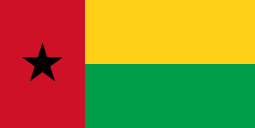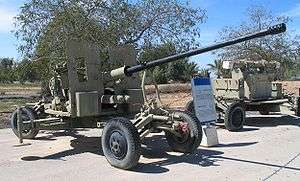AZP S-60
| 57 mm AZP S-60 | |
|---|---|
|
S-60 in an Israeli museum | |
| Type | Autocannon |
| Place of origin | Soviet Union |
| Service history | |
| In service | 1950–present |
| Used by | See users |
| Wars |
Vietnam War Cambodian Civil War Cambodian–Vietnamese War Iran–Iraq War Gulf War Iraq War numerous others |
| Specifications | |
| Weight | 4,660 kg (10,273 lbs) |
| Length | 8.5 m (27 ft 11 in) |
| Width | 2.054 m (6 ft 9 in) |
| Height | 2.37 m (7 ft 9 in) |
| Crew | 7 |
|
| |
| Shell | 57×348 mm. SR |
| Caliber | 57 mm (2.24 in) |
| Rate of fire |
105-120 rpm (cyclic) 70 rpm (sustained) |
| Muzzle velocity | 1,000 m/s (3,281 ft/s) |
| Effective firing range |
6,000 m (20,000 ft) (radar guided) 4,000 m (13,000 ft) (optically guided) |
57 mm AZP S-60 (Russian: Автоматическая зенитная пушка С-60, abbrev. АЗП (AZP); literally: Automatic anti-aircraft gun S-60) is a Soviet towed, road-transportable, short- to medium-range, single-barrel anti-aircraft gun from the 1950s. The gun was extensively used in Warsaw Pact, Middle Eastern and South-East Asian countries.
History
In the late 1940s, the Soviets started to develop a 57 mm anti-aircraft gun, to replace its 37 mm guns. Three different models were presented, and the winning design was made by V. G. Grabin. According to western intelligence sources, the German prototype gun 5,5 cm Gerät 58 formed the basis for the design. The Soviets were also able to study German 5 cm Flak 41 guns that had been captured following the Battle of Stalingrad.
The prototype passed the field tests in 1946 and was accepted into service in 1950, after some minor modifications. The anti-aircraft gun was given the name 57 mm AZP S-60. Grabin continued the development and fielded the SPAAG version ZSU-57-2 in 1955.
The fire direction device was developed from the German Lambda calculator (Kommandogerät 40, 40A, and 40B) and was called PUAZO-5A. It had also a distance measuring device called D-49. The fire direction was also made more effective by including Grom-2 (10 cm wavelength) radars to the AA-batteries. The whole system was called SON-9. Later on, the calculators would be changed into the more modern RPK-1 Vaza, which had been designed by M. M. Kositskin. The calculator and the radars were transported by Ural 375 trucks.
The 57 mm gun replaced the 37 mm divisional guns in Soviet service in the 1950s. A divisional anti-aircraft regiment consisted of two AA-batteries with six 57 mm guns each. The PVO air-defence troops AA-regiments consisted of four 57 mm AA-batteries (24 guns).
In the mid-1960s, the Soviet divisional anti-aircraft units began replacing their AA-guns with missiles, and by the end of the 1970s, the AA-guns had almost disappeared. However, they were used in many other countries. The performance of AAA in Vietnam against low-flying aircraft led the Soviets to bring back many guns from storage to supplement the Surface-to-Air Missiles, whose performance at low altitude was less than satisfactory.
Operational history
The S-60 and its Chinese copy (the Type 59) have seen combat in several wars all over the World, e.g. the Six-Day War and the Yom Kippur War in the Middle East and the Soviet war in Afghanistan. During the Vietnam War, the S-60 was the keystone of North Vietnamese low-altitude air defense and was most effective between 460 meters and 1,500 meters.
In Iraq (Iran–Iraq War, Gulf War and Iraq War), the S-60, normally deployed in battalions of 36 guns, served consistently in defense of divisional headquarters and field artillery assets.
Syrian S-60 guns were actively used during the Syrian Civil War by both the army and different rebel groups. As many other guns originally designed for antiaircraft use, most of the time they were used in shelling ground targets.[1]
The Islamic State shot down a Cessna 208 Caravan operated by the Iraqi Air Force near Hawija, Iraq on the 16th March 2016 with a truck-mounted S-60.[2][3][4][5]
Ammunition types
The S-60 fires ammunition in 57x348SR caliber, a cartridge noticeably weaker than the 57mm ammunition of either Bofors 57mm AA gun, or Soviet 57 anti-tank guns of World War II. Modern anti-aircraft rounds have not been developed for the gun - the main characteristics of the Soviet-era ammunition is listed in the table below. In addition to these People's Republic of China manufactures ammunition in 57x348SR caliber, designated Type 59 HE-T, Type 59 AP-T, and Type 76 HE-T.
Training rounds include a blank round MK-281 ("Manöver-Kartusche", East German designation), and training rounds with -IN suffix (UBR-281U-IN, UOR-281U-IN) identifying the rounds as fuzeless versions of the APCBC and HE rounds with dummy fuzes and inert filling replacing the explosive cavities.
| Designation | Type | Projectile Weight [g] | Bursting charge [g] | Muzzle Velocity [m/s] | Description |
|---|---|---|---|---|---|
| UBR-281/281U | APCBC-HE-T | 2820 [6] | 13 [6] | 1000 [6] | Anti-tank round with sharp penetrator, blunt cap and an aerodynamic cover, with tracer and a delayed-action base fuze.[6] Penetration 96 mm RHA at 1000 m range or 106mm at 500m.[7] UBR-281 and -281U are loaded with the same projectile and differ only by details in case mouth and swage grooves.[6] |
| UOR-281 | HE-T | 2850 [6] | 154 [6] | 1000 [6] | Impact-fuzed fragmentation shell for anti-aircraft use. Nose fuze with self-destruct function and a tracer.[6] |
| UOR-281U | HE-T | 2850 [6] | 154 [6] 168 [7] |
1000 [6] | Similar to UOR-281; some sources state the shell is the same as in UOR-281 and the round differs from it only in details of the case mouth and swage grooves (as with the UBR round),[6] while others claim a slightly larger HE filling.[7] |
| Type 59 AP | AP-T | ? | ? | ? | Chinese anti-tank round presumably similar to UBR-281/281U. |
| Type 59 HE | HE-T | ? | ? | ? | Chinese fragmentation round for anti-aircraft use, presumably similar to UOR-281/281U. |
| Type 76 HE | HE-T | ? | ? | ? | Chinese fragmentation round. |
Versions
- AK-725: Naval version of the S-60 gun. Introduced in 1958. Mounted in single, double and quadruple mounts (designated ZIF-31) on many early Soviet destroyers.
- ZIF-72: Naval version which is enclosed in a metal housing and fully automatic. Also exported to India. Introduced in the mid-1970s.
- ZSU-57-2: Self-propelled version with two 57 mm S-60 guns (designated S-68)
- Type-80: Chinese version of the ZSU-57-2.
- AU220M
- BM57
Operators

The S-60 was sold to at least 37 different countries during the Soviet era. The gun was also license manufactured in Poland by Zakłady Mechaniczne Tarnów in Tarnów (en. Tarnów Mechanical Works), and in Hungary by DIMÁVAG in Miskolc-Diósgyőr, and in China as the Type 59.
 Afghanistan
Afghanistan Albania
Albania Algeria: 70 units
Algeria: 70 units Angola
Angola Armenia
Armenia Bangladesh
Bangladesh Bosnia and Herzegovina
Bosnia and Herzegovina Bulgaria
Bulgaria Belarus
Belarus Cambodia
Cambodia People's Republic of China
People's Republic of China Republic of the Congo
Republic of the Congo Cuba: 400 units
Cuba: 400 units Czechoslovakia: 575 units. Passed on to successor states.
Czechoslovakia: 575 units. Passed on to successor states. Czech Republic
Czech Republic Egypt: 600 units
Egypt: 600 units Ethiopia
Ethiopia Finland: 12 units. Nicknamed Nikolai.
Finland: 12 units. Nicknamed Nikolai. Georgia: 60 units
Georgia: 60 units Guinea: 12 units
Guinea: 12 units Guinea-Bissau: 10 units
Guinea-Bissau: 10 units Hungary: 186 units (43 in store)
Hungary: 186 units (43 in store) India
India Indonesia: 256 units
Indonesia: 256 units Iran
Iran Iraq
Iraq Israel: Captured units
Israel: Captured units Kyrgyzstan: 24 units
Kyrgyzstan: 24 units Laos
Laos Libya: 90 units
Libya: 90 units Mali: 6 units
Mali: 6 units Morocco
Morocco Mauritania: 2 units
Mauritania: 2 units Moldova: 12 units
Moldova: 12 units Mozambique
Mozambique Mongolia
Mongolia Nicaragua
Nicaragua North Korea
North Korea Pakistan
Pakistan Poland: 500 units
Poland: 500 units Romania: 250 units
Romania: 250 units Russia
Russia Somalia
Somalia Soviet Union: Passed on to successor states
Soviet Union: Passed on to successor states Sudan: Both S-60 and Type 59 versions
Sudan: Both S-60 and Type 59 versions Slovakia
Slovakia Syria: 675 units
Syria: 675 units.svg.png) Free Syrian Army: Used by Syrian Rebels on various trucks chassis
Free Syrian Army: Used by Syrian Rebels on various trucks chassis Thailand: 24 units
Thailand: 24 units Turkmenistan: 22 units
Turkmenistan: 22 units Ukraine: 400 units
Ukraine: 400 units Vietnam
Vietnam Yemen: 120 units
Yemen: 120 units Yugoslavia: Passed on to successor states
Yugoslavia: Passed on to successor states Yugoslavia: retired
Yugoslavia: retired Zambia: ~30 units
Zambia: ~30 units
References
- ↑ https://www.youtube.com/watch?v=4ovUCOzzAZg
- ↑ http://www.janes.com/article/58851/islamic-state-claims-iraqi-cessna-shoot-down
- ↑ http://www.ibtimes.com/did-isis-shoot-down-iraqi-military-plane-islamic-state-group-claims-anti-aircraft-2337783
- ↑ http://aviation-safety.net/database/record.php?id=20160316-0
- ↑ http://www.dailymail.co.uk/news/article-3495947/Horrifying-video-shows-moment-Iraqi-plane-went-shot-sky-ISIS-extremists-anti-aircraft-gun.html
- 1 2 3 4 5 6 7 8 9 10 11 12 13 "Russian Ammunition Page, http://www.russianammo.org
- 1 2 3 "Jane's Ammunition Handbook, 1994
- Koll, Christian (2009). Soviet Cannon - A Comprehensive Study of Soviet Arms and Ammunition in Calibres 12.7mm to 57mm. Austria: Koll. p. 467. ISBN 978-3-200-01445-9.
External links
| Wikimedia Commons has media related to S-60 57 mm gun. |
